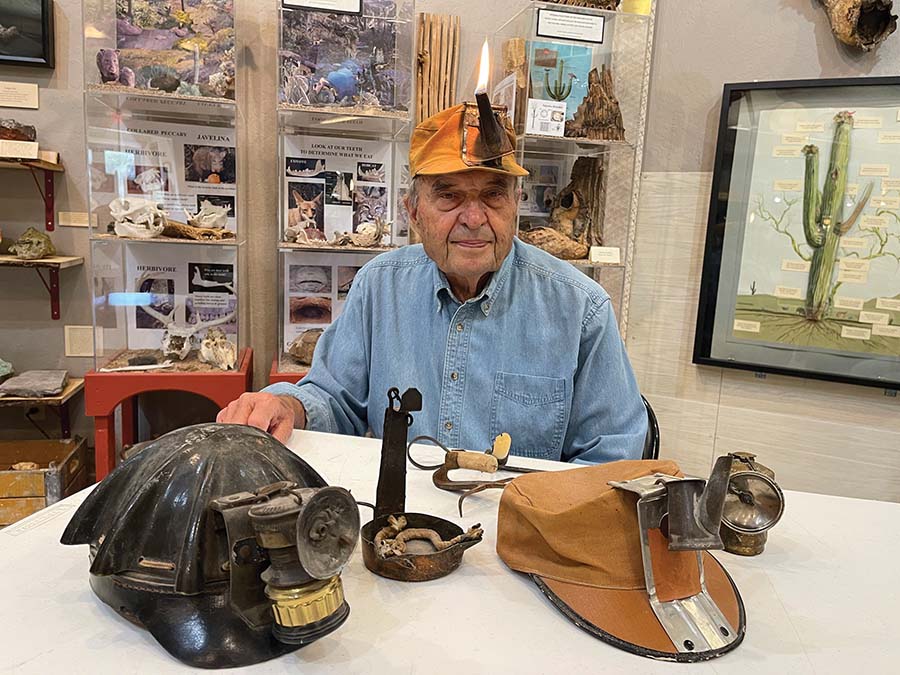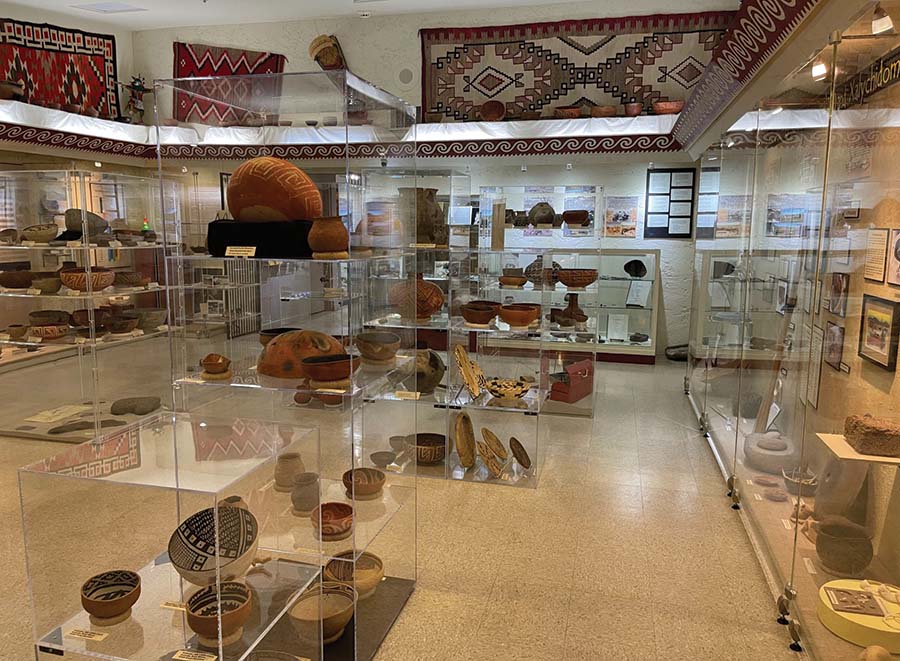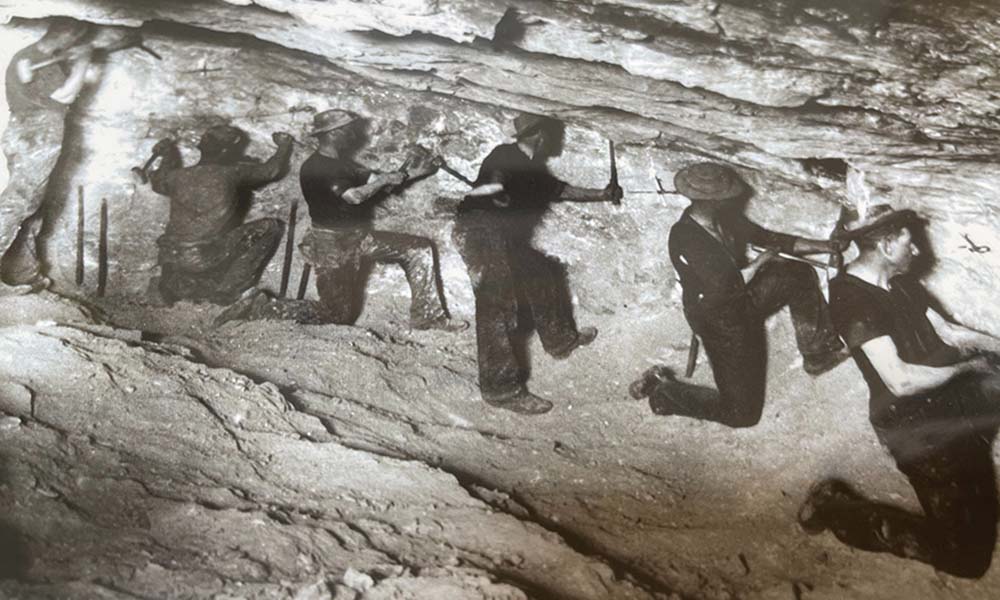Because mines are totally dark and dangerous, Cave Creek Museum’s mining professional Al Zeman shares insight into how miners explored different ways to provide illumination when mining for gold.
Early on, miners used torches until the invention of tallow candles. However, tallow was very soft and could be made at home. In the 1800s, candles were made specifically for miners. Later, miners’ candlesticks came in a variety of types and shapes. Miners with blacksmithing skills created their own unique candlesticks before moving on to wearing lamps on their hats that were filled with oil or grease and a wick (known as teapot lamps). By the late 1800s, underground mine lighting in the U.S. included candles and oil lamps.
“Unfortunately, all of these lights had an open flame which caused disastrous explosions or fire in the mine chambers,” says Zeman. “In the 1900s, oil was discovered leading to commercial petroleum, which became more common and affordable. After 1900, carbide miners’ lamps rapidly replaced oil and grease since the new lamp options were much brighter. Calcium carbide, invented in the 1800s, was made from subjecting lime and coal to a high electrical charge. The carbide chunks produced a gas when mixed with water to produce a bright white flame.”

It wasn’t until the late 1930s when electric lights were used for mine lighting.
Hats, Caps & Helmets
In the 1800s, safety wasn’t a major concern, so most miners wore a soft hat and secured a teapot lamp to the front. Candles were used prior but were pretty difficult to manage, flame-wise, while mining. Later, miner’s hats became common and could hold a carbide lamp or other lighting device. These were referred to as lamp caps.
“Between 1910-1920, safety became more of a concern,” says Zeman. “So, hats began being constructed of harder material (and called a helmet) that was durable and more suitable to supporting a carbide lamp. Today, these helmets are used so support a battery-powered electric light. Miner’s lamps and hats are rich part of Arizona’s mining history.”
Visitors and members can experience the excitement of days long past during the Saturday, January 13 and January 27, 2024 full demonstration of the Arizona Gold Mining Experience at the museum from 9-11:15 AM.
The excitement builds with the operation of the amazing Golden Reef Stamp Mill and Tramway, Arizona’s only fully operational ten-stamp ore crushing mill. The 10, 1,000-lb. stamps slam down in synchronized motion to pound ore removed from the mine into fine gravel. The stamp mill was brought from its former location at the Golden Reef Mine on Continental Mountain to Cave Creek Museum, which has the only fully operational mining stamp mill in its original mining district in Arizona; it is located just five miles from its site on the mountain. The giant stamp mill also is connected to a working tramway and ore carts that carry the ore to be pulverized to the stamp mill.
The experience continues as guests peer into a mineshaft to show the blasting techniques used by hard rock miners. Next, onto the blacksmith shop for a demonstration of the many skills used when parts and tools had to be fabricated onsite.
Guests then are encouraged to try their luck at the gold panning station, where museum volunteers show visitors how to pan for ore and minerals just like the prospectors did.
Admission is $15 for adults and children under 12 are free. Reservations are required. For those who want the thrill of the full Gold Fever package, pay for the AZGME and add $145 for the three-hour gold mine tour on January 13. By doing so, you support the entire gold mining experience and Cave Creek Museum. Reserve tickets online at cavecreekmuseum.org as there is a limit. Cave Creek Museum is located at 6140 E. Skyline Drive in Cave Creek, Ariz., 480.488.2764. Open October through May.
Museum Presents to “Archaeology of the Tonto National Forest”
On Saturday, February 3, 2024 from 2-4 PM, Cave Creek Museum will host “Archaeology of the Tonto National Forest.”

According to Evelyn Johnson, the museum’s executive director, the Tonto National Forest has a rich heritage reaching thousands of years into the past. Popular guest speaker Scott Wood will explain how originally, this area was home to several prehistoric Indian groups who hunted and gathered wild plants in the Mazatzal Mountains and Sierra Ancha and along the Salt and Verde Rivers and their tributaries. It was colonized more than 1,000 years ago by a related group of people known today as the Hohokam.
“Guests will learn about their life and home and see some of their pottery masterpieces in our Archaeology wing following the presentation,” says Johnson. “Don’t miss this program about ancient history in your own backyard!”
Members are free and non-members can enjoy the program for a $10 admission ticket. Register at cavecreekmuseum.org. No discounts or culture passes.
The 53-year-old museum’s mission is to preserve the artifacts of the prehistory, history, culture and legacy of the Cave Creek Mining District and the Cave Creek/Carefree foothills area through education, research and interpretive exhibits. The Cave Creek Museum is located at 6140 E. Skyline Drive in Cave Creek, Ariz. Open October through May. The museum can be reached at 480.488.2764 or cavecreekmuseum.org. Where History Comes Alive.







